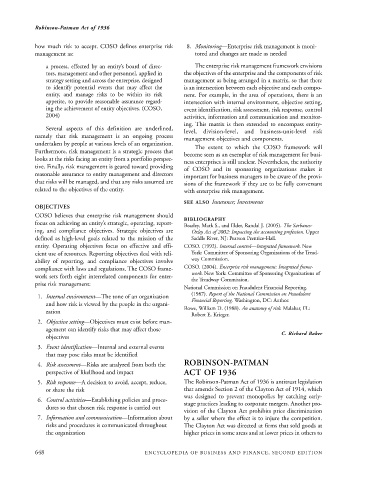Page 671 - Encyclopedia of Business and Finance
P. 671
eobf_R 7/5/06 3:20 PM Page 648
Robinson-Patman Act of 1936
how much risk to accept. COSO defines enterprise risk 8. Monitoring—Enterprise risk management is moni-
management as: tored and changes are made as needed
a process, effected by an entity’s board of direc- The enterprise risk management framework envisions
tors, management and other personnel, applied in the objectives of the enterprise and the components of risk
strategy setting and across the enterprise, designed management as being arranged in a matrix, so that there
to identify potential events that may affect the is an intersection between each objective and each compo-
entity, and manage risks to be within its risk nent. For example, in the area of operations, there is an
appetite, to provide reasonable assurance regard- intersection with internal environment, objective setting,
ing the achievement of entity objectives. (COSO, event identification, risk assessment, risk response, control
2004) activities, information and communication and monitor-
ing. This matrix is then extended to encompass entity-
Several aspects of this definition are underlined, level, division-level, and business-unit-level risk
namely that risk management is an ongoing process management objectives and components.
undertaken by people at various levels of an organization.
The extent to which the COSO framework will
Furthermore, risk management is a strategic process that
become seen as an exemplar of risk management for busi-
looks at the risks facing an entity from a portfolio perspec-
ness enterprises is still unclear. Nevertheless, the authority
tive. Finally, risk management is geared toward providing
of COSO and its sponsoring organizations makes it
reasonable assurance to entity management and directors
important for business managers to be aware of the provi-
that risks will be managed, and that any risks assumed are sions of the framework if they are to be fully conversant
related to the objectives of the entity. with enterprise risk management.
SEE ALSO Insurance; Investments
OBJECTIVES
COSO believes that enterprise risk management should
BIBLIOGRAPHY
focus on achieving an entity’s strategic, operating, report-
Beasley, Mark S., and Elder, Randal J. (2005). The Sarbanes-
ing, and compliance objectives. Strategic objectives are Oxley Act of 2002: Impacting the accounting profession. Upper
defined as high-level goals related to the mission of the Saddle River, NJ: Pearson Prentice-Hall.
entity. Operating objectives focus on effective and effi- COSO. (1992). Internal control—Integrated framework. New
cient use of resources. Reporting objectives deal with reli- York: Committee of Sponsoring Organizations of the Tread-
way Commission.
ability of reporting, and compliance objectives involve
compliance with laws and regulations. The COSO frame- COSO. (2004). Enterprise risk management: Integrated frame-
work. New York: Committee of Sponsoring Organizations of
work sets forth eight interrelated components for enter-
the Treadway Commission.
prise risk management:
National Commission on Fraudulent Financial Reporting.
(1987). Report of the National Commission on Fraudulent
1. Internal environment—The tone of an organization
Financial Reporting. Washington, DC: Author.
and how risk is viewed by the people in the organi-
Rowe, William D. (1988). An anatomy of risk. Malabar, FL:
zation
Robert E. Krieger.
2. Objective setting—Objectives must exist before man-
agement can identify risks that may affect those
C. Richard Baker
objectives
3. Event identification—Internal and external events
that may pose risks must be identified
4. Risk assessment—Risks are analyzed from both the ROBINSON-PATMAN
perspective of likelihood and impact ACT OF 1936
5. Risk response—A decision to avoid, accept, reduce, The Robinson-Patman Act of 1936 is antitrust legislation
or share the risk that amends Section 2 of the Clayton Act of 1914, which
was designed to prevent monopolies by catching early-
6. Control activities—Establishing policies and proce-
stage practices leading to corporate mergers. Another pro-
dures so that chosen risk response is carried out
vision of the Clayton Act prohibits price discrimination
7. Information and communication—Information about by a seller where the effect is to injure the competition.
risks and procedures is communicated throughout The Clayton Act was directed at firms that sold goods at
the organization higher prices in some areas and at lower prices in others to
648 ENCYCLOPEDIA OF BUSINESS AND FINANCE, SECOND EDITION

